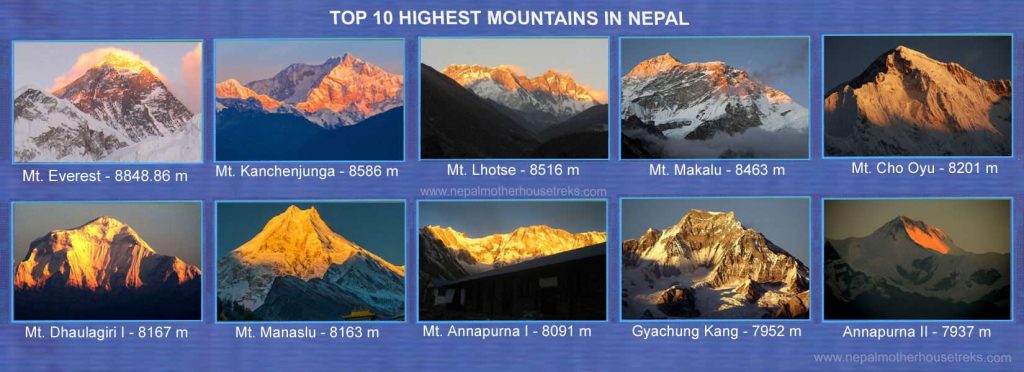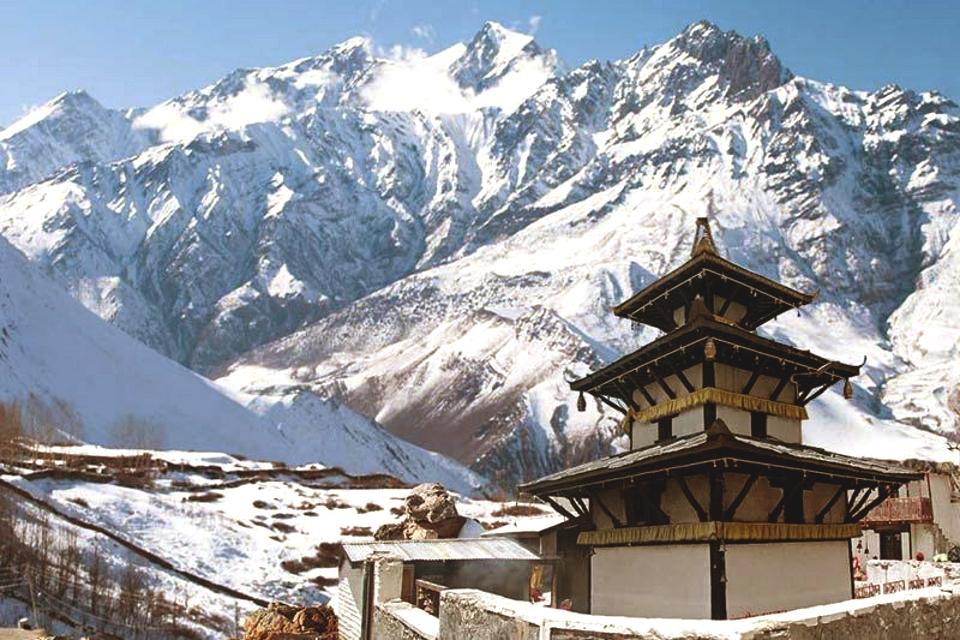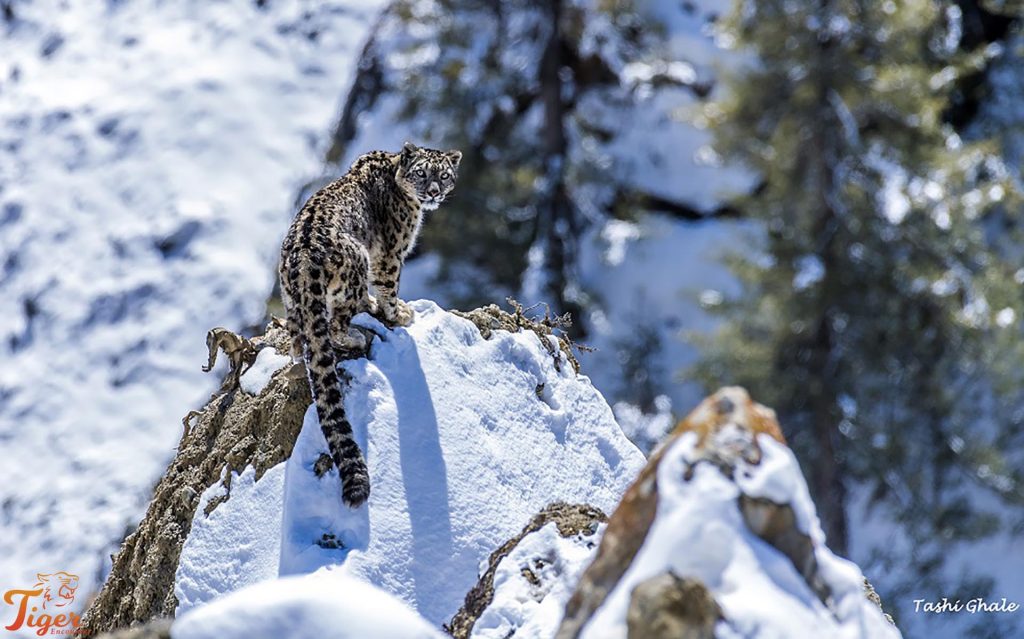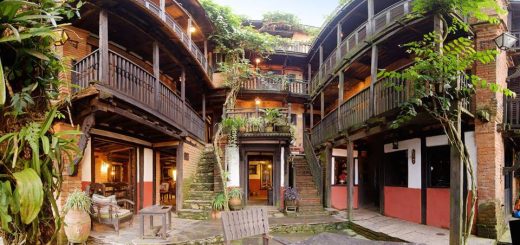The Majestic Himalayas of Nepal

The majestic Himalayas of Nepal stand tall as a testament to nature’s awe-inspiring grandeur. With its soaring peaks, rugged landscapes, and pristine beauty, the Nepalese Himalayas offer a journey into sublime magnificence that leaves visitors spellbound. Let us embark on an exploration of the Himalayan majesty that beckons adventurers and nature enthusiasts from around the world.
Rising like a mythical realm, Nepal is home to eight of the world’s fourteen highest peaks, including the mighty Mount Everest, the pinnacle of human achievement. As the roof of the world, the Nepalese Himalayas cast an enchanting spell, captivating the hearts and minds of those who dare to venture into their midst.
Contents
Top 10 Himalayas in Nepal

Here’s a tabular form listing the top 10 Himalayan peaks in Nepal, along with their height and other information:
| No. | Peak Name | Height (meters) | Prominence (meters) | First Ascent Year | Notes |
|---|---|---|---|---|---|
| 1 | Mount Everest | 8,848 | 8,848 | 1953 | Tallest peak in the world; located on the Nepal-China border |
| 2 | Kangchenjunga | 8,586 | 3,922 | 1955 | Third-highest peak in the world; located on the Nepal-India border |
| 3 | Lhotse | 8,516 | 610 | 1956 | Fourth-highest peak in the world; located on the Nepal-China border |
| 4 | Makalu | 8,485 | 2,386 | 1955 | Fifth-highest peak in the world; located on the Nepal-China border |
| 5 | Cho Oyu | 8,188 | 2,340 | 1954 | Sixth-highest peak in the world; located on the Nepal-China border |
| 6 | Dhaulagiri | 8,167 | 3,357 | 1960 | Seventh-highest peak in the world |
| 7 | Manaslu | 8,163 | 3,092 | 1956 | Eighth-highest peak in the world |
| 8 | Annapurna I | 8,091 | 2,984 | 1950 | Tenth-highest peak in the world |
| 9 | Gyachung Kang | 7,952 | 700 | 1964 | Located in the Mahalangur Himal subrange |
| 10 | Nuptse | 7,861 | 319 | 1961 | Located in the Khumbu region |
Challenges of Trekking and Adventure of Nepalese Himalayas
The Himalayan range stretches across the northern border of Nepal, providing a dramatic backdrop to the country’s landscape. From the rugged peaks of Annapurna and Dhaulagiri to the remote and ethereal beauty of Mustang and Dolpo, each region offers a unique and breathtaking experience.
Trekking through the Himalayas is a pilgrimage of the soul, where every step unveils panoramic vistas, pristine valleys, and cascading waterfalls. The iconic trails of Everest Base Camp, Annapurna Circuit, and Langtang Valley lure adventurers with their rugged charm and spiritual allure.
Some common Challenges…
| No. | Challenge | Adventure |
|---|---|---|
| 1 | High altitude | Stunning panoramic views |
| 2 | Extreme weather conditions | Thrilling trekking routes |
| 3 | Thin air and low oxygen levels | Experiencing unique cultures and traditions |
| 4 | Steep and rugged terrain | Challenging and rewarding climbs |
| 5 | Remote and isolated regions | Exploring pristine natural beauty |
| 6 | Physical endurance and fitness requirements | Personal growth and self-discovery |
| 7 | Acute Mountain Sickness (AMS) | Overcoming personal limitations |
| 8 | Basic living conditions and limited facilities | Immersion in a simpler way of life |
| 9 | Altitude-related health risks | Bonding with fellow trekkers and locals |
| 10 | Navigation and route finding challenges | Connecting with nature and finding inner peace |
Before Trekking in Nepal……
Please note that while trekking in the Nepalese Himalayas offers incredible adventures, it is essential to be well-prepared, physically fit, and knowledgeable about the challenges involved. It’s always recommended to trek with experienced guides and ensure proper acclimatization to mitigate risks.
Beyond trekking, the Himalayas offer a plethora of adventure activities. Mountaineering enthusiasts can test their mettle by attempting to conquer the formidable peaks while paragliding and zip-lining provide an adrenaline rush against the backdrop of snow-capped summits.
Spiritual Places in the LAP OF HIMALAYAS
The Himalayan region is not just a playground for adventurers; it is also a sanctuary for spiritual seekers. The tranquil monasteries and sacred sites nestled in the mountains offer solace and an opportunity for self-reflection. The peaceful chants and prayer flags fluttering in the wind create an atmosphere of serenity and reverence.

Here’s a list of some Himalayan regions in Nepal that are renowned for their spiritual significance:
Popular Spiritual place …
| No. | Himalayan Region | Spiritual Significance |
|---|---|---|
| 1 | Mount Kailash | Considered sacred by Hindus, Buddhists, Jains, and Bon |
| 2 | Muktinath | Important pilgrimage site for Hindus and Buddhists |
| 3 | Gosaikunda | Believed to be the abode of Hindu deity Shiva |
| 4 | Tengboche Monastery | Famous Buddhist monastery in the Everest region |
| 5 | Lumbini | Birthplace of Lord Buddha and a major Buddhist pilgrimage site |
| 6 | Manakamana Temple | Dedicated to the Hindu goddess Bhagwati |
| 7 | Swargadwari | Believed to be the gateway to heaven by Hindus |
| 8 | Tsum Valley | Known for its ancient Buddhist monasteries and cultural heritage |
| 9 | Shey Phoksundo Lake | Surrounded by Buddhist monasteries and spiritual traditions |
| 10 | Upper Mustang | Home to ancient Buddhist caves and monasteries |
These regions offer a serene and spiritual environment for those seeking a deeper connection and a sense of peace and tranquility. Visitors can immerse themselves in religious rituals, visit monasteries, participate in meditation retreats, and experience the rich spiritual heritage of Nepal’s Himalayas.
Bio-Diversity and Species in the Himalayas of Nepal

The Nepalese Himalayas are not just a feast for the eyes but also a haven for biodiversity. The region is home to rare and endangered species such as the elusive snow leopard, the colorful Himalayan monal, and the graceful musk deer. Exploring the Himalayan flora and fauna is like stepping into a living, breathing museum of nature’s wonders.
The Himalayas of Nepal are home to a diverse range of flora and fauna, thanks to the varied climatic zones and altitudes found in the region. Here are some examples of the biodiversity and species found in the Himalayas of Nepal:
Flora:
- Rhododendron: Nepal’s national flower, known for its vibrant colors.
- Blue poppy: A rare and beautiful flower found in high-altitude regions.
- Juniper: A coniferous tree species found in the subalpine and alpine regions.
- Orchids: Nepal has a rich variety of orchids, with over 500 species.
- Medicinal plants: The Himalayas of Nepal are known for their abundance of medicinal herbs and plants.
Fauna:
- Snow leopard: A highly endangered and elusive big cat found in high mountain regions.
- Red panda: A charming and endangered mammal known for its unique appearance.
- Himalayan black bear: Found in the forests of the Himalayas, it is the most common bear species in Nepal.
- Musk deer: Known for its musk secretion, this deer species inhabits higher elevations.
- Himalayan monal: A colorful bird species and the national bird of Nepal.
Birdlife:
- Himalayan vulture: One of the largest raptors in the region, found at higher elevations.
- Satyr tragopan: A beautiful and colorful pheasant species found in the eastern Himalayas.
- Himalayan owl: A nocturnal bird species adapted to the mountainous terrain.
- Blood pheasant: A unique bird species with red plumage, found in the alpine meadows.
- Rufous-necked hornbill: A large and charismatic bird species found in the lowland forests.
Insects and Invertebrates:
- Golden Himalayan scorpion: A venomous scorpion species found in the foothills.
- Hercules moth: One of the largest moth species in the world, found in the Himalayas.
- Himalayan jumping spider: A colorful and diverse group of spiders found in various habitats.
- Rhinoceros beetle: A large beetle species known for its impressive horn-like structures.
These examples represent just a fraction of the rich biodiversity found in the Himalayas of Nepal. The region’s unique ecosystems and habitats support a wide array of plant and animal life, making it a significant hotspot for conservation and nature enthusiasts.
Hospitality in Himalayan Foothills:
The local communities residing in the Himalayan foothills have a deep connection with the mountains. The warm hospitality and rich cultural traditions of the Sherpas, Gurungs, and Tamangs add a layer of human warmth to the Himalayan experience. Visitors can immerse themselves in the local way of life, enjoying traditional delicacies, witnessing age-old rituals, and partaking in festive celebrations.

Here are some aspects of hospitality you can expect to experience in the Himalayan foothills:
Homestays and Guesthouses:
In many villages and towns in the foothills, you’ll find homestays and guesthouses where locals open their homes to visitors. This allows you to experience the local culture firsthand and interact closely with the community.
Traditional Welcome:
Upon arrival, you can expect to receive a traditional welcome with garlands, tikas (vermilion marks on the forehead), and greetings. This gesture reflects the local customs and traditions and symbolizes warmth and respect.
Home-Cooked Meals:
Staying in a homestay or guesthouse often includes the opportunity to savor traditional home-cooked meals. Locals take pride in offering delicious Nepalese cuisine, which may include daal (lentil soup), rice, vegetables, and locally sourced ingredients.
Cultural Exchanges:
The communities in the foothills are often happy to share their cultural heritage with visitors. You may have the chance to witness traditional dances, music performances, or participate in local festivals, allowing you to immerse yourself in the local traditions.
Guided Village Walks:
Many villages offer guided walks where you can explore the surroundings, visit local landmarks, and gain insights into the community’s way of life. Local guides often share stories, legends, and historical anecdotes, enhancing your understanding of the region.
Tea/Coffee Culture:
Tea and coffee are an integral part of Nepalese culture. You may have the opportunity to experience the tea or coffee culture in the foothills, with locals brewing and serving aromatic teas like chiya (milk tea) or traditional Himalayan coffee made from local beans.
Warmth and Friendliness:
The people in the Himalayan foothills are known for their warmth, friendliness, and hospitality. Locals are often eager to engage in conversations, share their stories, and make visitors feel comfortable and welcome.
Traditional Handicrafts:
The foothills are home to skilled artisans who create beautiful handicrafts. You may have the chance to observe or even participate in traditional crafts like weaving, woodcarving, pottery, or painting. These crafts can also serve as souvenirs to take home.
The hospitality in the Himalayan foothills allows visitors to connect with the local culture, experience the warmth of the communities, and create lasting memories of their time in Nepal.
The Nepalese Himalayas are a testament to the indomitable spirit of nature and the resilience of the human soul. They inspire us to push our limits, connect with our inner selves, and appreciate the profound beauty that surrounds us.
In the realm of the Nepalese Himalayas, time stands still, and the magnitude of nature’s creation humbles even the most worldly of travelers. It is a place where dreams are born, challenges are embraced, and memories are etched into the fabric of our being. So, come and experience the Nepalese Himalayan majesty – a journey that will leave you forever changed and yearning for more.






I was suggested this website by my cousin. I am no longer positive whether or not this put up is written via him as no one else recognize such precise about my trouble. You’re amazing! Thanks!
What i do not understood is if truth be told how you’re no longer really much more well-favored than you may be right now. You are so intelligent. You understand therefore significantly in relation to this matter, made me in my opinion believe it from a lot of various angles. Its like men and women are not interested except it is something to do with Woman gaga! Your personal stuffs great. Always care for it up!
Its superb as your other blog posts : D, appreciate it for putting up. “So, rather than appear foolish afterward, I renounce seeming clever now.” by William of Baskerville.